It will be a webcast live next month.
On April 25, two pilots, Luke Aikins and Andy Farrington will jump out of their single-seater aircraft and attempt to switch planes as they plummet towards the Earth, energy drink company, Red Bull has announced on its website.
Red Bull is no stranger to such daring attempts. Rather the company prides itself in supporting adventurers who want to achieve extraordinary feats. Whether it is flying planes inside tunnels or jumping in and out of a volcano with nothing but a wingsuit, Red Bull is at forefront of supporting these daredevils and next month is no different. April 25, two pilots will jump out of their single-seater aircraft and attempt to switch planes as they plummet towards the Earth.




